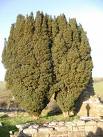Florida Yew Tree Information
Images of Florida Yew:






Florida Yew grows in the following 1 states and provinces:
FloridaInformation about Florida Yew:
as well ashe Taxus Floridana is commonly known as the Florida Yew.
The currently accepted scientific name for Florida yew is Taxus floridana Nutt. ex Chapm. . There are no accepted infrataxa.Florida yew is known only from bluffs and ravines along the Apalachicola River in northwestern Florida, in Gadsden and Liberty counties . Several populations occur along a 15-mile stretch of the river . A single population was reported by Kurz in an Atlantic white-cedar (Chamaecyparis thyoides) swamp 8 miles southeast of Bristol, Florida. The Nature Conservancy, however, reported that no further observations of the Atlantic white-cedar swamp population have been made .Florida yew usually occurs in small clonal stands or clumps and rarely as individual stems . It occurs as disjunct populations of several hundred to several thousand stems per hectare in hardwood forests dominated by American beech (Fagus grandiflora) and southern magnolia (Magnolia grandiflora), in both open forest habitats and dense mountain-laurel (Kalmia latifolia) thickets. It is an important component of the forest understory in some drainages . Florida yew occurs in habitats which include the rare Florida torreya (Torreya taxifolia), false hellebore (Veratrum woodii), and bladdernut (Staphylea trifolia). More common species occurring with Florida yew include laurel oak (Quercus laurifolia), American beech, horse sugar (Symplocos tinctoria), highbush blueberry (Vaccinium corymbosum), and in an Atlantic white-cedar swamp, inkberry (Ilex glabra) . Additional species that occur with Florida yew as reported by Southeastern Forestry Services include white oak (Q. alba), mockernut hickory (Carya tomentosa), tree sparkleberry (V. arboreum), and yaupon (I. vomitoria). On lower slopes the forests are dominated by American beech, southern magnolia, and American holly (I. opaca). In some ravines Florida yew occurs in dense stands of fetterbush (Leucothoe racemosa), mountain-laurel, greenbriers (Smilax spp.), and canebreak (Arundinaria spp.). No indicator species associated with Florida yew have yet been identified. Southeastern Forestry Services suggested that differences in soil, aspect, moisture, or a combination of these factors may influence the distribution of Florida yew, and that further research is needed.Some of the information provided here is attributed to:Sullivan, Janet. 1993. Taxus floridana. In: Fire Effects Information System, [Online]. U.S. Department of Agriculture, Forest Service, Rocky Mountain Research Station, Fire Sciences Laboratory (Producer). , available at the USDA Fire Effects Information System (FEIS) website